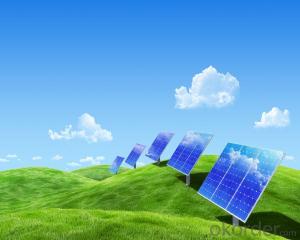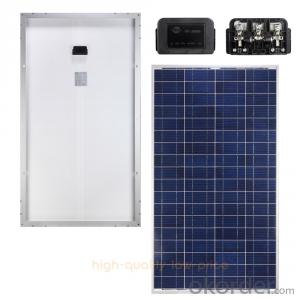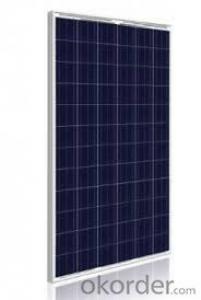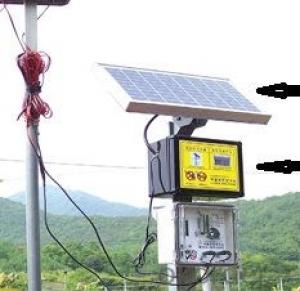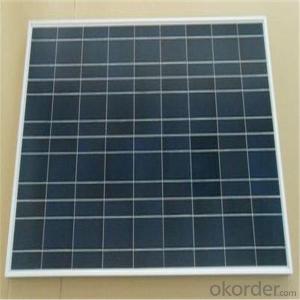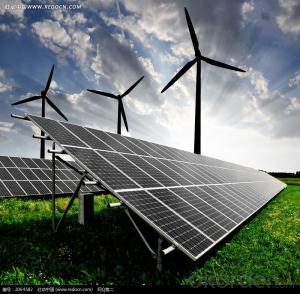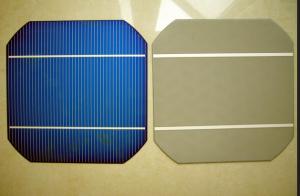Sunpower Solar Cells 235w Poly Solar Panel with 25 Years Warranty CNBM
- Loading Port:
- Qingdao
- Payment Terms:
- TT OR LC
- Min Order Qty:
- 10 set
- Supply Capability:
- 300000 set/month
OKorder Service Pledge
OKorder Financial Service
You Might Also Like
Polycrystalline Solar Modules
CNBM offers a range of small, medium and large polycrystalline solar modules, designed for a range of requirements.
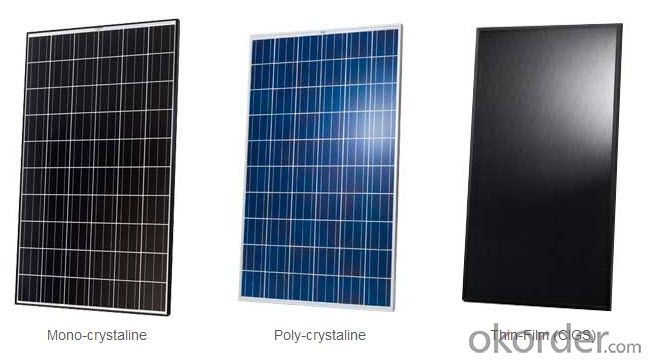
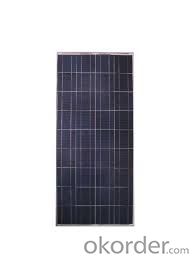
Specifications:
Tolerance | +/-3% |
Cell | Polycrystalline silicon solar cells (156 x 156mm) |
N0. of Cells | 60 (10 x 6) |
Dimension of Modules (mm) | 1650 x 990 x 40 |
Weight (kg) | 25.5 |
Limits:
Operating Temperature | -40~+85? |
Storage Temperature | -40~+85? |
Maximum System Voltage | 1000 VDC max. |
Hail Impact | Diameter of 28mm with impact speed |
Temperature and Coefficients:
NOCT | 48C+/-2? |
Voltage temperature coefficient (%/K) | -0.35 |
Current temperature coefficient (%/K) | 0.05 |
Power temperature coefficient (%/K) | -0.45 |
Characteristics:
Model: | SGM-200P | SGM-210P | SGM-220P |
Max-power voltage Vmp (V) | 29.2 | 29.4 | 29.41 |
Max-power current Imp (A) | 6.85 | 7.14 | 7.48 |
Open-circuit voltage Voc (V) | 36.5 | 36.69 | 36.9 |
Short-Circuit Current Isc (A) | 7.28 | 7.6 | 7.93 |
Max-power Pm(W) | 200 | 210 | 220 |
Model: | SGM-230P |
Max-power voltage Vmp (V) | 29.8 |
Max-power current Imp (A) | 7.72 |
Open-circuit voltage Voc (V) | 37.31 |
Short-Circuit Current Isc (A) | 8.19 |
Max-power Pm(W) | 230 |
STC: Irradiance 1000W/m2, module temperature 25?, AM-=1.5
Poly Crystalline Solar Panels Specifications Range
Maximum Power (Pm) | Dimension | Weight | Operating Voltage (Vmp) | Operating Current (Imp) | Open Circuit Voltage (Voc) | Short Circuit Current (Isc) |
0.45W | 140x80x10mm | 0.08kg | 3.3V | 150mA | 4.6V | 160mA |
1.0W | 162x140x10mm | 0.16kg | 7.5V | 150mA | 10.3V | 160mA |
4.5W | 269x251x23mm | 0.8kg | 16.5V | 0.27A | 20.5V | 0.3A |
10W | 420.1×268.9×22.6mm | 1.92kg | 17.5V | 0.58A | 20.5V | 0.6A |
20W | 425x502x50mm | 3.0kg | 16.8V | 1.19A | 21.0V | 1.29A |
30W | 593x502x22.6mm | 3.9kg | 16.8V | 1.78A | 21.0V | 1.94A |
40W | 655x537x50mm | 5.75kg | 17.3V | 2.31A | 22.1V | 2.54A |
50W | 839x537x50mm | 6.0kg | 17.5V | 2.9A | 21.8V | 3.17A |
65W | 1111x502x50mm | 7.2kg | 17.6V | 3.69A | 22.1V | 3.99A |
80W | 1204x537x50mm | 7.7kg | 17.6V | 4.55A | 22.1V | 4.8A |
- Q: Can solar cells be used for indoor lighting?
- Yes, solar cells can be used for indoor lighting. However, they are generally less efficient indoors compared to outdoor environments due to the reduced amount of sunlight available. Additionally, indoor lighting usually requires a constant and reliable power source, which may be challenging to achieve solely through solar cells.
- Q: What is the impact of wind on solar cell efficiency?
- The impact of wind on solar cell efficiency is generally negative. Strong winds can create turbulence around solar panels, causing them to vibrate or move, which can potentially damage the cells or the overall system. Additionally, excessive wind can lead to dust and debris accumulation on the surface of the panels, reducing their ability to absorb sunlight and convert it into electricity efficiently. Therefore, it is important to consider the effects of wind and implement proper measures, such as secure mounting and regular cleaning, to minimize any negative impact on solar cell efficiency.
- Q: Can solar cells be used to power surveillance cameras?
- Yes, solar cells can be used to power surveillance cameras. Solar power provides a reliable and sustainable energy source for surveillance systems, making them independent of the electrical grid. This allows cameras to be placed in remote locations or areas without access to electricity, while still maintaining continuous operation.
- Q: Can solar cells be used for powering sports stadiums?
- Yes, solar cells can be used for powering sports stadiums. Solar panels can be installed on the roofs or surrounding areas of stadiums to harness solar energy and convert it into electricity. This renewable energy source can help power various systems within the stadium, such as lighting, scoreboards, electronic displays, and even charging stations. Additionally, excess energy generated by the solar cells can be stored in batteries for use during nighttime events or periods of low sunlight. Using solar cells in sports stadiums not only reduces carbon emissions but also offers long-term cost savings by decreasing reliance on traditional energy sources.
- Q: Can solar cells be used in grid-tied systems?
- Yes, solar cells can be used in grid-tied systems. Grid-tied systems, also known as grid-connected or grid-interconnected systems, allow solar energy to be generated and used simultaneously with the utility grid. Solar cells, which convert sunlight into electricity, can be integrated into these systems to generate clean and renewable energy that can be fed into the grid, offsetting the use of conventional power sources and potentially earning credits or incentives.
- Q: What's the benefit of using a solar cell?
- It can help avoid the greenhouse effect.
- Q: What is the typical lifespan of a solar cell?
- The typical lifespan of a solar cell is around 25 to 30 years.
- Q: Can solar cells be used in disaster relief efforts?
- Yes, solar cells can be used in disaster relief efforts. They are a reliable and sustainable source of energy that can provide electricity in areas affected by natural disasters, where power grids may be damaged or non-existent. Solar cells can be used to power emergency lighting, communication systems, medical equipment, and water purification systems, among other essential needs. Additionally, solar energy can be harnessed to charge mobile devices and provide a means of communication and access to information during these critical times. Overall, solar cells are a valuable tool in disaster relief efforts, offering a clean and renewable energy solution to support affected communities.
- Q: How do solar cells perform in snowy conditions?
- Solar cells do not perform optimally in snowy conditions due to the reduced sunlight reaching the cells. Snow cover can significantly decrease the efficiency of solar panels as it blocks sunlight from reaching the cells, limiting their ability to generate electricity. Additionally, snow accumulation on the panels can create a physical barrier that further hinders their performance. Regular cleaning and tilting the panels to shed snow are some ways to mitigate the impact of snowy conditions on solar cell performance.
- Q: Can solar cells be used in indoor applications?
- Yes, solar cells can be used in indoor applications. While they are typically designed for outdoor use to harness sunlight, indoor solar cells can still generate electricity from artificial light sources such as fluorescent or LED lights. However, the efficiency of indoor solar cells is generally lower compared to outdoor usage due to the lower intensity and variability of indoor lighting.
Send your message to us
Sunpower Solar Cells 235w Poly Solar Panel with 25 Years Warranty CNBM
- Loading Port:
- Qingdao
- Payment Terms:
- TT OR LC
- Min Order Qty:
- 10 set
- Supply Capability:
- 300000 set/month
OKorder Service Pledge
OKorder Financial Service
Similar products
Hot products
Hot Searches
Related keywords













